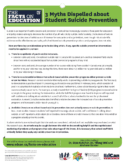3 Myths Dispelled about Student Suicide Prevention
It is necessary that school staff think critically before they apply any suicide prevention intervention
Suicide is an important health concern and prevention at school has increasingly become a focal point for educators and policy makers aiming to decrease the number of youth who die by suicide. Unfortunately, the business of suicide prevention has become a fruitful source of revenue for companies and organizations, even though robust scientific evidence on the effectiveness and safety of school-based suicide prevention products and programs does not exist.
Here are three key considerations prior to deciding which, if any, specific suicide prevention interventions need to be applied in a school:
1. There is no epidemic of youth suicide in Canada.
- Between 1980 and 2005, the national suicide rate in Canada fell by about 30% and has remained fairly stable since then with no substantial input from suicide prevention programs of any kind.
- Between 2012 and 2016, the average number of 10-14-year-olds dying from suicide in Canada was 36 annually and for 15-19-year-olds was 199. During this time, there were about 1.9 million 10-14-year-olds and 2.1 million 15-19-year-olds living in Canada.
2. There is no substantial evidence that school-based suicide prevention programs either prevent suicide or are harmless.
Research cannot conclude what really works in preventing suicide in young people. The first study to demonstrate a positive impact in preventing youth suicide was published in February 2019, which considered youth in a psychiatric hospital and not students at school. Furthermore, some school-based programs that report success actually cause harm. For example, a study showed that the Signs of Suicide (SOS) program increased suicide attempts in the group receiving the intervention, while the SafeTALK program was found to improve self-reported self-confidence in talking about suicide but caused half of the students involved to be sent for professional evaluation. A recent Canadian review also identified a relation between the increased use of suicide prevention programs and increased suicide rates in young girls.
3. Available literature on school-based suicide prevention does not actually measure suicide prevention.
At best, most studies measure students’ self-reported knowledge about suicide, self-confidence in talking about suicide, or self-reported suicide attempts or ideation. None of these are valid measures that can determine whether a program actually prevents suicide.
Student suicide is an emotional topic that demands our considered, rational and best available response based on what the research says.
As schools may be caught between the wish to do something helpful and the sophisticated marketing of products and programs that take advantage of this intent, it is necessary that school staff think critically before they apply any suicide prevention intervention.
Additional Information Resources
Statistics Canada: Suicide rates: An overview
TeenMentalHealth.org:
References
Knightsmith P. Youth suicide prevention research needs a shake-up: lives depend on it. 2018. Accessible from https://www.nationalelfservice.net/mental-health/suicide/youth-suicide-prevention-research-needs-a-shake-up-lives-depend-on-it/
Kutcher S., Wei Y. The vexing challenge of suicide prevention: a research informed perspective on a recent systematic review. 2016. Accessible from https://www.nationalelfservice.net/mental-health/suicide/vexing-challenge-suicide-prevention-research-informed-perspective-recent-systematic-review/
King CA., Arango A., Kramer A., et., al. Association of the Youth-Nominated Support Team Intervention for Suicidal Adolescents With 11- to 14-Year Mortality Outcomes. Secondary Analysis of a Randomized Clinical Trial. JAMA Psychiatry. 2019. doi:10.1001/jamapsychiatry.2018.4358
Schilling EA, Lawless M, Buchanan L, et al. Signs of Suicide shows promise as a middle school suicide prevention program. Suicide Life Threat Behav. 2014; 44(6): 653-67.
Bailey E, et al. Universal Suicide Prevention in Young People: An evaluation of the safeTALK Program in Australian High Schools. Crisis. 2017; 38(5), 300-308.
Kutcher S., et al. School-and Community-Based Youth Suicide Prevention Interventions: Hot Idea, Hot Air, or Sham? The Canadian Journal of Psychiatry. (2016): 1-7.

